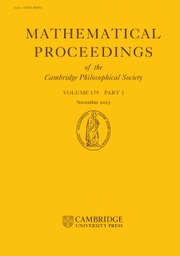No CrossRef data available.
Article contents
On the quasi-transitivity degree of branch groups
Published online by Cambridge University Press: 04 August 2025
Abstract
An action of a group G on a set X is said to be quasi-n-transitive if the diagonal action of G on  $X^n$ has only finitely many orbits. We show that branch groups, a special class of groups of automorphisms of rooted trees, cannot act quasi-2-transitively on infinite sets.
$X^n$ has only finitely many orbits. We show that branch groups, a special class of groups of automorphisms of rooted trees, cannot act quasi-2-transitively on infinite sets.
MSC classification
Secondary:
20E08: Groups acting on trees
Information
- Type
- Research Article
- Information
- Mathematical Proceedings of the Cambridge Philosophical Society , Volume 179 , Issue 3 , November 2025 , pp. 695 - 715
- Copyright
- © The Author(s), 2025. Published by Cambridge University Press on behalf of Cambridge Philosophical Society
References
Alexoudas, T., Klopsch, B. and Thillaisundaram, A.. Maximal subgroups of multi-edge spinal groups. Groups Geom. Dyn. 10(2)(2016), 619–648.CrossRefGoogle Scholar
Bartholdi, L., Grigorchuk, R. I. and Šuni, Z.. Branch groups. In: Handb. Algebr. vol. 3 Elsevier/North-Holland, Amsterdam, 2003, 989–1112.Google Scholar
Belk, J. and Zaremsky, M. C. B. Twisted Brin–Thompson groups. Geom. Topol. 26(3)(2022), 1189–1223.CrossRefGoogle Scholar
Bondarenko, I. V.. Finite generation of iterated wreath products. Arch. Math. (Basel) 95(4)(2010), 301–308.CrossRefGoogle Scholar
Cameron, P. J.. Transitivity of permutation groups on unordered sets. Math. Z. 148(2)(1976), 127–139.CrossRefGoogle Scholar
Cameron, P. J.. Finite permutation groups and finite simple groups. Bull. London Math. Soc. 13(1)(1981), 1–22.CrossRefGoogle Scholar
Cameron, P. J.. Oligomorphic Permutation Groups. London Math. Soc. Lecture Note Series, vol. 152 (Cambridge University Press, Cambridge, 1990).CrossRefGoogle Scholar
Cameron, P. J.. Aspects of infinite permutation groups. In Groups St. Andrews 2005, vol. 1. London Math. Soc. Lecture Note Ser. vol. 339 (Cambridge University Press, Cambridge, 2007), 1–35.Google Scholar
Chaynikov, V. V.. Properties of hyperbolic groups: Free normal subgroups, quasiconvex subgroups and actions of maximal growth. (ProQuest LLC) (Ann Arbor, MI) (PhD. thesis. Vanderbilt University (2012).Google Scholar
de Cornulier, Y.. Finitely presented wreath products and double coset decompositions. Geom. Dedicata 122 (2006), 89–108.CrossRefGoogle Scholar
Dixon, J. D. and Mortimer, B.. Permutation Groups. Graduate Texts in Math. vol 163 (Springer-Verlag, New York, 1996) vol. 163.CrossRefGoogle Scholar
P. Fima, F. Le Maître, Moon, S. and Stalder, Y.. A characterisation of high transitivity for groups acting on trees. Discrete Anal. pages Paper No. 8, 63, 2022.Google Scholar
Francoeur, D.. On maximal subgroups of infinite index in branch and weakly branch groups. J. Algebra 560 (2020), 818–851.CrossRefGoogle Scholar
Francoeur, D. and Garrido, A.. Maximal subgroups of groups of intermediate growth. Adv. Math., 340 (2018), 1067–1107.CrossRefGoogle Scholar
Garion, S. and Glasner, Y.. Highly transitive actions of
 ${\rm Out}(F_n)$
. Groups Geom. Dyn. 7(2)(2013), 357–376.CrossRefGoogle Scholar
${\rm Out}(F_n)$
. Groups Geom. Dyn. 7(2)(2013), 357–376.CrossRefGoogle Scholar
Glasner, Y., Souto, J. and Storm, P.. Finitely generated subgroups of lattices in
 ${\textrm PSL}_2\mathbb{C}$
. Proc. Amer. Math. Soc. 138(8)(2010), 2667–2676.CrossRefGoogle Scholar
${\textrm PSL}_2\mathbb{C}$
. Proc. Amer. Math. Soc. 138(8)(2010), 2667–2676.CrossRefGoogle Scholar
Grigorchuk, R. I.. On the Milnor problem of group growth. Dokl. Akad. Nauk SSSR 271(1)(1983), 30–33.Google Scholar
Grigorchuk, R. I.. Just infinite branch groups. In New Horizons in Pro-p Groups. Progr. Math. vol. 184 (Birkhäuser Boston, Boston, MA, 2000), 121–179.CrossRefGoogle Scholar
Grigorchuk, R. I.. Solved and unsolved problems around one group. In Infinite Groups: Geometric, Combinatorial and Dynamical Aspects. Progr. Math. vol. 248 (Birkhäuser, Basel, 2005), 117–218.CrossRefGoogle Scholar
Hull, M. and Osin, D.. Transitivity degrees of countable groups and acylindrical hyperbolicity. Israel J. Math. 216(1)(2016), 307–353.CrossRefGoogle Scholar
Klopsch, B. and Thillaisundaram, A.. Maximal subgroups and irreducible representations of generalised multi-edge spinal groups. Proc. Edinburgh. Math. Soc. (2), 61(3)(2018), 673–703.CrossRefGoogle Scholar
Le Boudec, A. and Matte Bon, N.. Triple transitivity and non-free actions in dimension one. J. London. Math. Soc. (2) 105(2)(2022), 884–908.CrossRefGoogle Scholar
McDonough, T. P.. A permutation representation of a free group. Quart. J. Math. Oxford Ser. (2), 28(111)(1977), 353–356.CrossRefGoogle Scholar
Pervova, E. L.. Everywhere dense subgroups of a group of tree automorphisms. Tr. Mat. Inst. Steklova 231 (Din. Sist., Avtom. i Beskon. Gruppy) (2000), 356–367.Google Scholar
Pervova, E. L.. Maximal subgroups of some non locally finite p-groups. Internat. J. Algebra Comput. 15(5–6)(2005), 1129–1150.CrossRefGoogle Scholar
Tsankov, T.. Automorphism groups and their actions. Thèse présentée en vue de l’obtention de l’Habilitation à Diriger des Recherches, Université Paris Diderot (2014).Google Scholar
Wilson, J. S.. Groups with every proper quotient finite. Camb. Phil. Soc. 69(1971), 373–391.CrossRefGoogle Scholar

